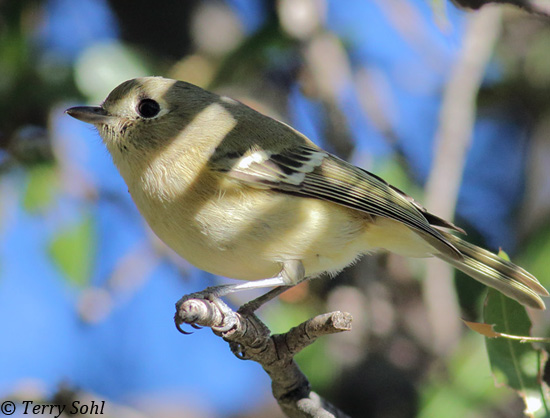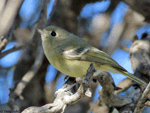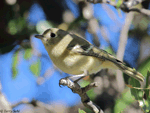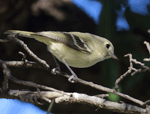Hutton's Vireo
Vireo huttoni
| Length: 5 inches | Wingspan: 8 inches | Seasonality: Non-resident in South Dakota |
| ID Keys: Plain olive gray overall, lighter underside, white eye-ring, 2 white wing-bars, stubby stout bill, pale lores | ||
 The
Hutton's Vireo is a stocky, thick-billed vireo of the western United States.
While similar in plumage to some other vireo species, it is more often
confused with a Ruby-crowned Kinglet, given it's structure and bill.
individual populations of the Hutton's Vireo are separated geographically in
many locations, and some studies have shown slight plumage and structural
differences, as well as genetic differences, that may indicate they are in
fact separate species.
The
Hutton's Vireo is a stocky, thick-billed vireo of the western United States.
While similar in plumage to some other vireo species, it is more often
confused with a Ruby-crowned Kinglet, given it's structure and bill.
individual populations of the Hutton's Vireo are separated geographically in
many locations, and some studies have shown slight plumage and structural
differences, as well as genetic differences, that may indicate they are in
fact separate species.
Habitat: Found in oak and oak-pine forests and woodlands, in forested riparian areas, in areas of dense, tall shrubs, and in evergreen forests with a dense understory.
Diet: Feeds mostly on insects and spiders, but also feeds on fruits and berries, especially during the winter months.
Behavior: Forages by hopping through the understory or usually relatively low in the forest canopy, searching for insects. They will also capture insects while hovering.
Nesting: The nest is a cup made of grasses, moss, lichens, bark, a spider webs, placed in a tree. Both the parents help to incubate the eggs, and both parents feed and care for the young upon hatching.
Song: Song of a Hutton's Vireo is series of slowly repeated phrases, with phrases changing occasionally.
Migration: Considered a permanent resident throughout their range, but individuals do sometimes move very short distances to lower elevations for the winter.
Interactive eBird Map: Click here to access an interactive eBird map of Hutton's Vireo sightings
Similar Species: Similar to other vireos, including Cassin's Vireo, Blue-headed Vireo, and Plumbeous Vireo, but with their stockier body and short stout bill, they are most often confused with the Ruby-crowned Kinglet.
Conservation Status: There are no major conservation threats at this time to the Hutton's Vireo, and populations may be increasing. The IUCN lists the Hutton's Vireo as a species of "Least Concern".
Further Information: 1) WhatBird - Hutton's Vireo
2) BirdWeb.org - Hutton's Vireo
3) Audubon Guide - Hutton's Vireo
Photo Information: November 11th, 2015 - Florida Canyon, south of Tucson, Arizona - Terry Sohl
| Click below for a higher-resolution map |
 |
| South Dakota Status: Non-resident in South Dakota |
Additional Hutton's Vireo Photos




